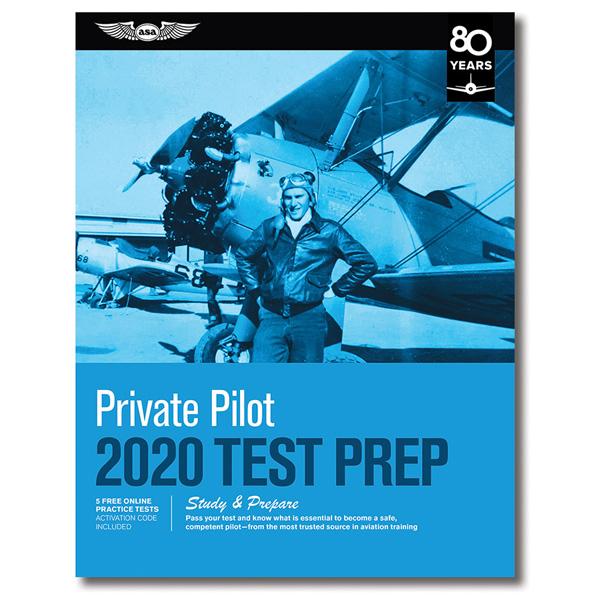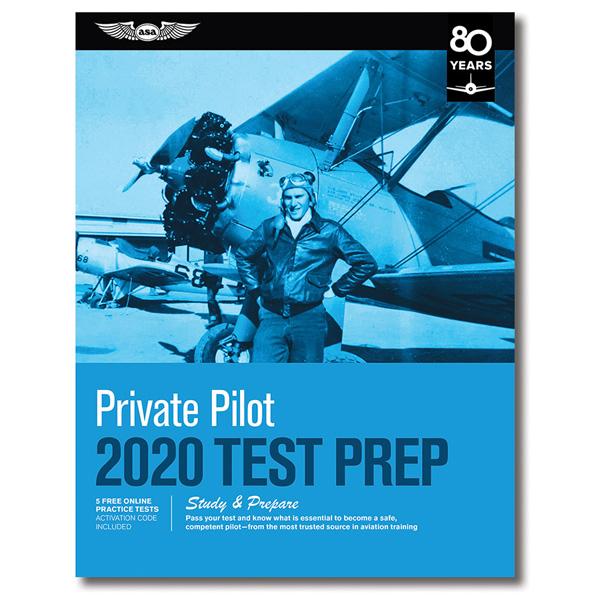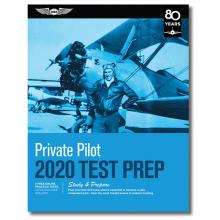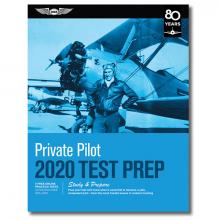ASA TEST PREP 2020: PRIVATE PILOT TEST PREP




- Questions supported with explanations for correct and incorrect answers, FAA references for further study, and airman test report codes for remedial study
- Organized by subject with introductory text for efficient and logical study
- Certificate requirements
- 5 Free online practice tests and test authorization (endorsement) with ASA's online simulated testing program at no additional cost!
- Quick cross-references for easy question-finding
- Free online updates and free subscription service to keep you informed of test changes
- Tips and instructions for taking your official FAA Knowledge Exam
- Includes the official FAA Computer Testing Supplement (FAA test figures)
- Pass your test and know what is essential to become a safe, competent pilot from the most trusted source in aviation training.
Version Types
eBook PD - A protected document that looks identical to its print book counterpart. Exact formatting and layout of the print books is maintained (text, images, margins, page breaks, etc.). Displays best on 10-inch or larger screens. Not recommended for small screens (phones) which require you to zoom in and pan around to see the full page. This document is not a .pdf file type. It is a .acsm file type. See http://asa2fly.com/use-ebooks for more details on how to setup your device.
Softcover Book - Printed book with heavyweight cover stock.
eBook EB - A protected document designed for reflowable content. Also referred to as an ePub or "Electronic Publication" format. Easily viewed on both small and large screens. Text, images, and pages will adapt or reflow to fit the screen size of the device, so zooming is not necessary to read. Text size can be adjusted in an ebook reader app. Visit http://asa2fly.com/use-ebooks for more details on how to setup your device.
eBundle - Includes both the print book and eBook PD.
Reader Resources
New Codes Coming to Airman Test Reports
The FAA sample questions for the Private Pilot Airplane (PAR) and the Instrument Rating Airplane Airman Knowledge Tests now show two types of codes associated with each question:
- 1. The Learning Statement Code (LSC) associated with question topic areas. The Learning Statement codes currently appear on the Airman Knowledge Test Report for any missed knowledge test questions.
- 2. The “Airman Certification Standards” (ACS) code for question topic areas. The FAA expects the ACS codes to replace LSCs on the Private and Instrument Airman Knowledge Tests within the next 12 – 18 months.
For a detailed presentation and FAQs on the ACS (Click Here)
Airman Certification Standards
Since September 2011, the FAA has worked closely with a diverse group of aviation community stakeholders, including ASA, who convened to help the agency improve the testing/training standards, guidance, and test development/management components of the airman certification process. The industry participants in this effort have developed the Airman Certification Standards (ACS) framework as a way to improve airman training and testing by providing an integrated, holistic system that clearly aligns airman testing with certification standards and guidance. ACS is built on the existing Practical Test Standards (PTS), which explicitly define the performance metrics for each flight proficiency element listed in 14 CFR. The ACS approach enhances the PTS by defining the specific elements, aeronautical knowledge, and risk management awareness needed to support each Area of Operation and Task.
By presenting the elements of knowledge, skill, and risk management in the integrated ACS format, the ACS approach better serves the applicant, the instructor, and the evaluator. In addition, the ACS approach will enable the FAA to create and maintain a clear link between the regulations, knowledge/skill performance standards, guidance, and test materials.
The FAA has accepted the industry group’s recommendation to adopt the ACS approach and continues to work with this group to refine the ACS and plan for its eventual implementation. Current endeavors include FAA support for industry efforts to prototype the ACS approach in selected locations.
Airman Certification Standards (ACS) Codes
The overarching goal of the ACS effort is to create an integrated, coherent airman certification system in which standards, guidance, and testing can be aligned and maintained in alignment. This type of symmetry in all materials is key to fully realizing the benefits the ACS system promises to both the FAA and its many stakeholders. It is also the key to conformance with accepted industry standards for certification programs, which require that items to be trained and tested are directly linked to the job/task analysis—in this case, the ACS.
To help achieve this goal, the aviation community experts who developed the ACS have also created a new coding system that will eventually apply to both Airman Knowledge Tests and Practical Test tasks. These codes provide the means to correlate the tasks in the ACS with guidance and testing and to keep them aligned going forward. When the FAA implements the ACS approach, the ACS codes will supersede the current LSC system, which has become too limited to serve as a mechanism for alignment and too complex to effectively serve the needs of the FAA and the stakeholder community.
The proposed coding system has four elements that are anchored in the ACS and not in reference documents, as are the current LSCs. Examples:
PA . XI. A. K1
- PA = Identifies the applicable ACS (private pilot airplane)XI = Area of Operation (Night operation)A = Task (Night preparation)K1 = Task element [knowledge (K), skill (S), risk management (R)] (1. Physiological aspects of night flying as it relates to vision)
- IR = Identifies the applicable ACS (instrument rating)I = Area of Operation (Preflight preparation)A = Task (Pilot qualifications)K1 = Task element [knowledge (K), skill (S), risk management (R)] (1. When an instrument rating is required)
- Clearly align guidance and test questions to the ACS;
- Make the airman test report meaningful to stakeholders (applicant, instructor, evaluator);
- Provide a means for automated generation of tests, whether using the existing test forms or future randomized selections
- Eliminate subjectivity and vastly simplify system management requirements for the FAA.
In The Box
Softcover Book- 1 - Softcover book
- 1 - CT-8080-2H computer testing supplement
- 5 - FREE practice tests at prepware.com!
- 1 - Softcover book
- 1 - CT-8080-2H Computer Testing Supplement
- 1 - Prepware Download Edition
- 1 - FREE 24-month subscription to Prepware Online.
- 1 - Activation Code
- 1 - CT-8080-2H Computer Testing Supplement
- 1 - Prepware Download Edition
- 1 - FREE 24-month subscription to Prepware Online.
- 1 - Prepware install disc
- 1 - FREE 24-month subscription to Prepware Online.

Отзывы ещё не добавлены